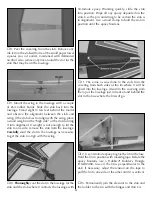
3. Turn on the transmitter and receiver. One at a
time, operate each control on the airplane using the
transmitter. Make certain each control is responding
correctly. This
must
be done before
every
flight.
There are several types of malfunctions that can be
discovered by performing this elementary task, thus
saving your model!
RANGE CHECK THE RADIO
A range check
must
be performed before the
first
flight of a new model. It is not necessary to do a
range check before every flight (but is not a bad idea
to perform a range check before the first flight of
each day). A range check is the final opportunity to
reveal any radio malfunctions and to be certain the
system has adequate operational range.
1.
BE CERTAIN
you have the frequency clip.
2. Turn on the transmitter and receiver. Leave the
transmitter antenna all the way down. Walk away from
the model while simultaneously operating the controls.
Have an assistant stand by the model and tell you what
the controls are doing to confirm that they operate
correctly. You should be able to walk approximately
100 feet from the model and still have control without
any “glitching” or inadvertent servo operation.
3. If everything operates correctly, return to the model
and start the engine. Perform the range check with
your assistant holding the plane with the engine
running at various speeds. If the servos chatter or
move inadvertently, there may be a problem.
Do not
fly the plane! With the assistance of your instructor,
look for loose servo connections or binding pushrods.
Also be certain you are the only one on your
frequency and that the battery has been fully charged.
GROUND CHECK
If the engine is new, follow the engine manufacturer's
instructions to break-in the engine.
After break-in,
confirm that the engine idles reliably, transitions
smoothly and rapidly to full power and maintains full
power—indefinitely. After you run the engine on the
model, inspect the model closely to make sure all
screws remained tight, the hinges are secure, the prop
is secure and all pushrods and connectors are secure.
Keep all engine fuel in a safe place, away from high
heat, sparks or flames, as fuel is very flammable. Do
not smoke near the engine or fuel; and remember
that engine exhaust gives off a great deal of deadly
carbon monoxide. Therefore do not run the engine
in a closed room or garage.
Get help from an experienced pilot when learning to
operate engines.
Use safety glasses when starting or running engines.
Do not run the engine in an area of loose gravel or
sand; the propeller may throw such material in your
face or eyes.
Keep your face and body as well as all spectators
away from the plane of rotation of the propeller as
you start and run the engine.
Keep these items away from the prop: loose
clothing, shirt sleeves, ties, scarfs, long hair or loose
objects such as pencils or screwdrivers that may fall
out of shirt or jacket pockets into the prop.
Use a “chicken stick” or electric starter to start the
engine. Do not use your fingers to flip the propeller.
Make certain the glow plug clip or connector is
secure so that it will not pop off or otherwise get into
the running propeller.
Make all engine adjustments from behind the
rotating propeller.
The engine gets hot! Do not touch it during or right
after operation. Make sure fuel lines are in good
condition so fuel will not leak onto a hot engine,
causing a fire.
To stop a glow engine, cut off the fuel supply by closing
off the fuel line or following the engine manufacturer's
recommendations. Do not use hands, fingers or any
other body part to try to stop the engine. Do not throw
anything into the propeller of a running engine.
Failure to follow these safety precautions may
result in severe injury to yourself and others.
Engine Safety Precautions
26

















